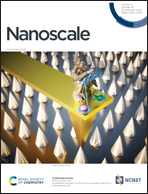Elucidating the anomalous membrane permeability of Ag(i), Cu(ii), Zn(ii) and Au(iii) towards new nanoreactor strategies for synthesizing metal nanoparticles†
Abstract
The main structural element defining the cell is the lipid membrane, which is an integral part of regulating the fluxes of ion and nutrition molecules in and out of the cell. Surprisingly, copper ions were found to have anomalous membrane permeability. This led us to consider a broader spectrum of cations and further a new approach for using liposomes as nanoreactors for synthesis of metal and metal alloy nanoparticles. In the present study, the high membrane permeability of Cu2+ and its neighbouring transition elements in the periodic table was investigated. The permeability of Ni2+, Cu2+, Zn2+, Ag+, Au3+, Mg2+, Ca2+ and Lu3+ was assessed, and we report that Zn2+, Cu2+, Ag+ and Au3+ surprisingly are able to cross lipid bilayers. This knowledge is highly relevant for understanding trafficking of cations in biological systems, as well as for design of novel nanoparticle and nanoreactor systems. An example of its use is presented as a platform for synthesizing single highly uniform gold nanoparticles inside liposomal nanoreactors. We envision that this approach could provide a new nanoreactor methodology for forming highly structurally constrained uniform metal and metal alloy nanoparticles, as well as new methods for in vivo tracking of liposomes.



 Please wait while we load your content...
Please wait while we load your content...